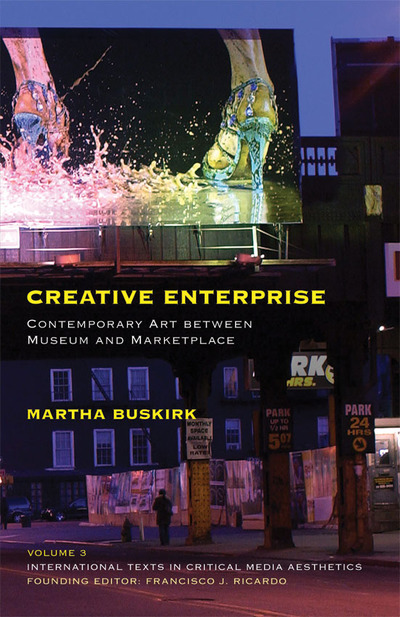Art and Its Representation—A Tense Negotiation

Creative Enterprise: Contemporary Art between Museum and Marketplace
By Martha Buskirk
Continuum Books
ISBN: 978-1-4411882-0-5
392 pages, $39.95
W hen judging a book by its title, I tend to gravitate to the nouns, but in the case of Martha Buskirk’s new book, I would have been better served paying attention to the preposition “between.” In a book filled with examples of how artists and museums have negotiated their differences, Buskirk primarily explores how artists have altered the space separating the studious museological zone and the commercial market.
Regardless of age or media, the work of art in a museum today plays numerous tacit and implied roles. As the mus-eum adjusts and supplements its core competence (exhibiting, studying, and collecting), the signification of the works in a museum’s collection also shifts in important and subtle ways. The use of the museum’s prestige to influence the careers of contemporary artists is one obvious example. While an encyclopedic museum defines a work of art’s importance with historical scholarship, the museum that collects, exhibits, and (most importantly) commissions contemporary works gains a level of prominence from the untested artists with whom it collaborates. Unlike the encyclopedic museum that endows the work with importance, the contemporary museum requires the art displayed to make the museum important. But in a world where a museum can feel more like an art fair than a connoisseur’s collection, and (more awkwardly) may team up with commercial galleries for exhibitions and commissions, how do you unravel who is benefiting from any given relationship? Simply, what are the concerns and limits of the relationships between the museum and artist?
How things get converted is a major theme. That magical transformation from studio idea to museum masterpiece is not just about the quality of the painting. For starters, using painting as a synonym for art is a pointless anachronism, and the work of art is not always as simple as a discrete object anymore. Formal histories of contemporary art often need to describe a work’s variables—how the site changes any formal meanings or maybe just the incongruity in what materials were exhibited as the “individual” artwork.
Buskirk devotes most of her third chapter, “Kaprow’s Vector,” to mapping the wide range that Allan Kaprow’s Yard installation took. Dated to 1961, Yard was reproduced at least ten times with no two iterations looking the same or using identical materials. The adaptations between any two iterations look nothing alike, yet somehow each version is dated to the same year, 1961. By giving the artist the privilege of declaring two artworks the same, when the work patently isn’t the same, what rights are we granting to the role of artist and what relationship should art historians, museums, and writers have to these objects’ facts?
While this book is not a thorough definition of how museums and artists should work together, it is an incredibly crowded sourcebook demonstrating the range with which museums and artists have worked jointly, including the artists who claim to eliminate museums, galleries, and studios altogether. These post-studio artists make their works either out of nontraditional materials (Thai food, for example) or exhibit events with justifications that are all but impossible to capture or, sometimes, to sustain. These tortuous events-as-art exist via the images and descriptions that document them for everyone but the few who delighted in the artistic moment. In most examples, that moment seems incapable of continuing for very long. These art occasions are like architectural ruins, incomplete fragments that are experienced by most viewers in modes that are completely unlike the original event.
The art experience immediately converts into an object from history. The history associated with the event is written by the artist. These savvy producers function as curator and critic as they create the specific temporal aesthetic locations and the ensuing, irrefutable objects that serve as a surrogate for the event. All documents that arise from the event agree with their creator’s vision of the event. Regardless of whatever actually happened or was aesthetically expressed by the artist, the approved version is held as the truth. Did 2009’s theanyspacewhatever show at the Guggenheim “describe a cinematic moment defined by multiple perspectives that are unmoored from the coordinates of time and space”? It did if the artists say it did. The most remarkable thing to remember from theanyspacewhatever, other than the free espresso, was Carsten Höller’s rotating bed installed at the top of the Guggenheim’s ramp. If you were lucky enough to stay in this exclusive hotel room, I think you probably might locate that event in time and space, no matter how many perspectives are implicated in the work.
____________________________________________________________________________________
John Pyper is an independent curator and critic based in Cambridge, Massachusetts. He is a contributor to Dailyserving.com, Printeresting.org, NewAmerican Paintings.com, and more.
